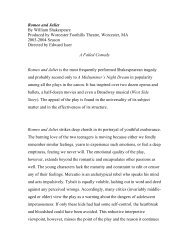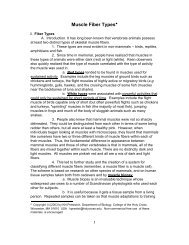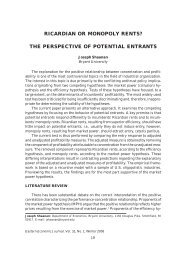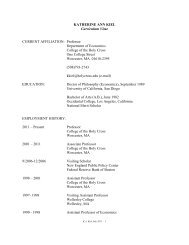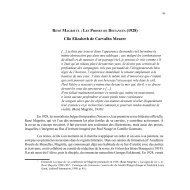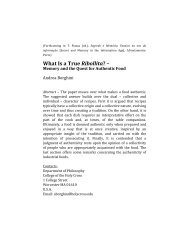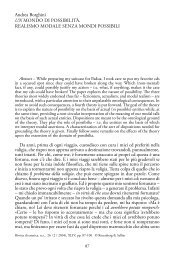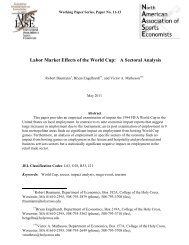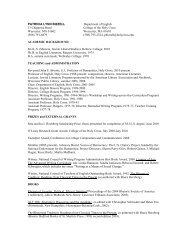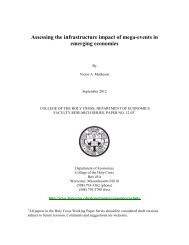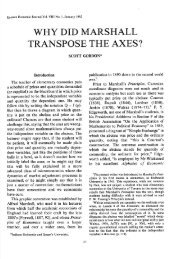29-2 Singh.pmd - College of the Holy Cross
29-2 Singh.pmd - College of the Holy Cross
29-2 Singh.pmd - College of the Holy Cross
You also want an ePaper? Increase the reach of your titles
YUMPU automatically turns print PDFs into web optimized ePapers that Google loves.
CAPITAL ACCOUNT LIBERALIZATION<br />
NOTES<br />
213<br />
I am grateful for helpful comments from Philip Arestis as well as from session participants at <strong>the</strong><br />
EEA meeting in Boston in March 2002. Since I could not attend <strong>the</strong> meeting, Philip kindly presented<br />
an earlier version <strong>of</strong> this paper on my behalf. That I am also indebted to Joseph Stiglitz’s writings on<br />
<strong>the</strong> subject, despite important disagreements, will be clear from <strong>the</strong> paper. It is also a pleasure to<br />
record my gratitude to <strong>the</strong> editor and <strong>the</strong> four referees <strong>of</strong> this Journal, whose sometimes fierce comments<br />
greatly helped to improve <strong>the</strong> paper. This work was carried out at <strong>the</strong> Centre for Business<br />
Research at Cambridge University. The Centre’s contributions are gratefully acknowledged. The<br />
usual caveat applies.<br />
1. For a comprehensive survey and a recent contribution, see for example Feldstein [2002].<br />
2. This section <strong>of</strong> <strong>the</strong> paper draws on Chakravarty and <strong>Singh</strong> [1988].<br />
3. Such a mechanism, for example, existed in <strong>the</strong> “Golden Age” <strong>of</strong> <strong>the</strong> post-WWII era (1950-1973) when,<br />
under <strong>the</strong> aegis <strong>of</strong> a single hegemonic economic power, namely <strong>the</strong> U.S., European economies were<br />
able to maintain high levels <strong>of</strong> aggregate demand to ensure full employment [Glyn et al., 1990; <strong>Singh</strong>,<br />
1995a].<br />
4. See fur<strong>the</strong>r Freeman [1989]; <strong>Singh</strong> [1995b]; Amsden [2001].<br />
5. The US was willing to open its own markets to East Asian manufacturers without insisting on reciprocal<br />
opening <strong>of</strong> East Asian market. See fur<strong>the</strong>r, Glyn et al., [1990].<br />
6. See Passinetti [1981] for a fuller discussion <strong>of</strong> <strong>the</strong> learning approach to this issue.<br />
7. On this set <strong>of</strong> issues, see for example, Stiglitz [1994]; Allen and Gale [2000]; Glen, Lee and <strong>Singh</strong><br />
[2000].<br />
8. A referee has objected that since Kaminsky and Reinhart [1999] and Demigüc-Kunt and Detragiache<br />
[1998] include both developing countries and advanced countries, it is not legitimate to draw conclusions<br />
about developing countries alone from this evidence. However, as argued in <strong>the</strong> text below,<br />
developing countries are more prone to financial crises following liberalization than Acs. Considering<br />
<strong>the</strong> two group <strong>of</strong> countries toge<strong>the</strong>r will underestimate <strong>the</strong> strength <strong>of</strong> <strong>the</strong> relationship between<br />
financial liberalization, banking and currency crisis and underdevelopment ra<strong>the</strong>r than to overstate<br />
it.<br />
9. For fuller discussion <strong>of</strong> <strong>the</strong>se issues see <strong>Singh</strong> [2002a]; Jomo [2001]; <strong>Singh</strong> and Weisse [1999] and<br />
Rodrik [2000].<br />
10. IMF [2002, Box 3.4, 126], broadly supports <strong>the</strong>se conclusions.<br />
11. A referee has pointed out that <strong>the</strong>re is a greater difference in volatility between advanced countries<br />
and developing countries in terms <strong>of</strong> trade compared with capital flows. However, changes in terms<br />
<strong>of</strong> trade may be caused ei<strong>the</strong>r by capital flows or current account balance, or both, as well as o<strong>the</strong>r<br />
factors. This important issue will not be pursued here.<br />
12. Similar results are reported in IMF [2002].<br />
13. For a fuller discussion <strong>of</strong> <strong>the</strong> issues involved in this argument see Cosh, Hughes and <strong>Singh</strong> [1990] and<br />
<strong>Singh</strong> [2000].<br />
14. This and <strong>the</strong> following sections are based on <strong>Singh</strong> [2001].<br />
15. See <strong>Singh</strong> and Zammit [1998] for a fur<strong>the</strong>r discussion.<br />
16. This is <strong>the</strong> empirical definition <strong>of</strong> FDI adopted by many countries to distinguish it from portfolio<br />
flows.<br />
17. A referee has pointed out that <strong>the</strong> problems <strong>of</strong> FDI volatility create difficulties not just for developing<br />
countries but also for <strong>the</strong> U.S. where <strong>the</strong>re has been a substantial drop in FDI recently.<br />
18. See <strong>Singh</strong> [1997a; 1997b]; <strong>Singh</strong> and Weisse [1998] for a fur<strong>the</strong>r discussion.<br />
REFERENCES<br />
Agosin, M. R. and Mayer, R. Foreign Investment in Developing Countries: Does it Crowd in Domestic<br />
Investment? United Nations Conference on Trade and Development, Discussion Paper, No. 146.<br />
February 2000.<br />
Aitken, B. J., and Harrison, A. E. Do Domestic Firms Benefit from Direct Foreign Investment? Evidence<br />
from Venezuela. American Economic Review, June 1999, 605-18.



